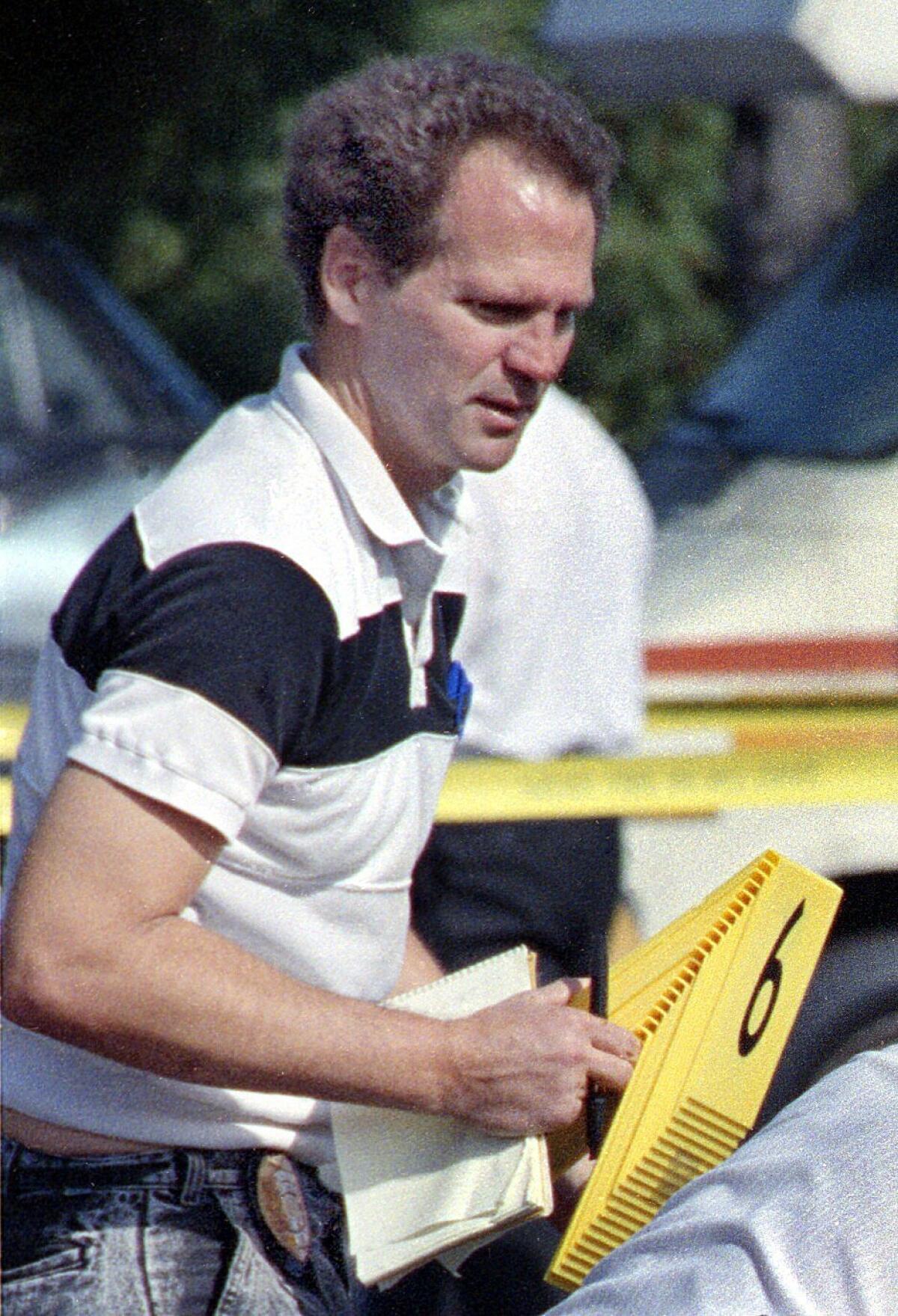Were teens mutilated by same killer?
New DNA evidence questions whether 1978, 1984 murders are linked
The crimes were chillingly similar. The same San Diego beach. Two teen girls beaten in the head, mutilated with a knife, parts of the breast sliced off. Strangled to death. Wet sand stuffed in their mouths.
Barbara Nantais, 15, and Claire Hough, 14, were both out-of-towners, from Long Beach and Rhode Island, respectively, who felt the same draw to Torrey Pines State Beach on August days, six years apart.
For decades, as their murders remained unsolved, it was hard to mention one case without mentioning the other. There were just too many similarities to imagine the brunettes weren’t killed by the same person.


Last week, San Diego police said they’ve solved one of the murders. DNA evidence linked two men — retired San Diego police criminalist Kevin Charles Brown and violent criminal Ronald Clyde Tatro — to Claire’s 1984 killing, police said.
But no evidence has surfaced that links either one to Barbara’s 1978 death, said San Diego homicide Capt. Al Guaderrama.
Barbara’s murder is still an open investigation, but police say Claire’s killing is case closed. Tatro died in 2011 in an apparent boating accident in Tennessee. And on Tuesday, Brown’s body was found hanging from a tree in Cuyamaca State Park in an apparent suicide.
Brown’s widow is adamant that her husband is innocent, and that his suicide was not an admission of guilt but of being driven mad by the police’s accusations against him. She claims his DNA match doesn’t implicate him of murder, but is instead proof of contamination of evidence at the police lab where he worked for 20 years — a possibility that authorities say has been ruled out.
The strikingly similar murders that have haunted detectives for decades have diverged into complex investigations, sparking fresh questions with no easy answers. Are there more clues to be uncovered, or have the best leads died with the two suspects?
Danger at the beach
Barbara’s body was found on the beach, near lifeguard tower #7, the morning of Aug. 13, 1978. She had driven down from Long Beach with her boyfriend at the time, and the couple had spent the night in zipped-together sleeping bags on the sand. Her boyfriend was beaten unconscious in his sleep, and he stumbled dazed and bloodied the next morning to a car where his friends were sleeping.
Her body was found nude, spread eagle, her right nipple sliced off. She had facial injuries, a cracked skull and strangulation marks, according to the autopsy report.
Claire’s body suffered many of the same injuries. The Rhode Island teen was visiting her grandparents, who lived in nearby Del Mar Heights. She walked to the beach alone on Aug. 23, 1984, with a portable radio and pack of cigarettes. A man who lived in the area found her body about 5 a.m. and called police from a nearby convenience store.
Claire was found lying on a white towel, her body mutilated by cuts, her face bruised, her left breast removed with a knife. Her jeans were found torn open and pulled halfway down her hips.
Police have not said whether either teen was raped, although both autopsy reports show the girls suffered injuries consistent with sexual assault of some kind. No semen was recovered from their bodies.
Investigators recovered DNA from three unidentified females and two males that was found on cigarette butts near Claire’s body, police said. Witnesses told police that they saw a group of people hanging out on the beach in that area that night.
Cases linked
The FBI offered assistance to the investigations, and in 1995 told police the killings were likely committed by the same perpetrator. The cold case homicide website also suggested a connection.
Claire’s parents, Samuel and Penelope Hough, had their own suspicions.
When the grieving parents visited the site of their daughter’s murder two days later, they spoke with a lifeguard, who told them the man who had discovered Claire’s body was down the beach. The man, Wallace Howard Wheeler, was known in the area. He collected aluminum cans.
At first they started toward him, but thought better of it. They felt sure the discovery would have been shocking to him. Maybe he was a suspect.
“Despite popular fiction and television programs, amateurs don’t solve criminal cases, and that’s not what we were there for,” Samuel Hough said in a recent interview.
But Wheeler sought them out. He proceeded to inform the family, with seemingly little sympathy, that he was a psychic and had envisioned an angelic girl would be killed by two men. When Samuel and Penelope returned to Rhode Island, they received letters every week for more than a month from the strange man on the beach.
“His letters were bizarre,” he said.
Samuel Hough said he would photocopy the notes and send them to police. Guaderrama said detectives investigated Wheeler, but determined fairly quickly that he wasn’t involved in the death.
Claire’s father said he didn’t remember if that conclusion was something detectives shared with him early on, but if they did, he and his wife likely didn’t put much stock in it. He was the only likely suspect in their minds — until the DNA matches.
The parents were told about Brown’s death days ago.
Wheeler also met a tragic end. He jumped off the 13th-floor balcony of his downtown San Diego apartment building in 1988 at the age of 65. He had been diagnosed with emotional problems and had not been taking his medication of late, his daughter told authorities. He had tried to kill himself two years earlier by driving off a cliff, she said. Numerous writings on his thoughts on religion were found in his apartment, the autopsy report said.
Cases reopened
In 2012, the cold case team took yet another crack at both murder investigations. Around the same time, Barbara’s former boyfriend, who was beaten alongside her in the first attack, was putting pressure on investigators to solve the crimes, according to his blog posts.
“This is a case we really wanted to solve,” Guaderrama said Friday.
Police ran DNA from the evidence through a national database of criminals’ DNA for a match. As it turns out, the database also includes DNA and fingerprints of crime lab personnel, to safeguard against false matches.
In November 2012, the database got a hit on both Tatro and Brown on samples taken from Claire’s body, launching an exhaustive follow-up investigation. Guaderrama said all efforts were made to determine if the criminalist’s DNA somehow contaminated the evidence mistakenly, and investigations concluded that was impossible. Brown never worked on any part of the case, the homicide captain said.
Guaderrama said the case against the two men involves other evidence, but he declined to elaborate for now.
Investigators determined Tatro, an Army veteran, had died a year earlier. When they tried to link him to the first murder, they found he was nowhere near San Diego. He was serving prison time in 1978 for a kidnapping in Arkansas. He had snatched a young woman from a liquor store, stuffed her in the trunk of his car, and raped her. He was sentenced to 40 years in prison, but for unknown reasons, only served eight, Guaderrama said. He was out before Claire’s killing. A year later he kidnapped a La Mesa teen. He was sentenced to another three years in prison.
The investigation turned to Brown, whose suspected involvement continues to leave doubts, particularly for those who knew him. He passed an independently administered polygraph test, his lawyer said. But the accusations — whether true or not — appear to have been too much. His wife was told there was no suicide note.
As for the first murder, Brown’s lawyer said he also had an alibi: He was working in New Mexico.
